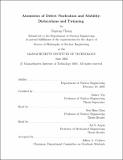Atomistics of defect nucleation and mobility : dislocations and twinning
Author(s)
Chang, Jinpeng, 1974-
DownloadFull printable version (19.53Mb)
Other Contributors
Massachusetts Institute of Technology. Dept. of Nuclear Engineering.
Advisor
Sidney Yip.
Terms of use
Metadata
Show full item recordAbstract
Multiscale materials modeling has emerged in recent years as a significant concept and the only viable approach to understand the mechanical response of materials by linking modeling research at different length scales and time scales, including quantum mechanics, atomistics modeling, mesoscale modeling and continuum modeling together. The role that atomistic modeling plays is important and indispensable in that it can generate understanding of the physics and pass this mechanistic understanding as well as important parameters to higher level simulations. This thesis presents theories and simulations of defect nucleation and mobility in BCC transition metal molybdenum using atomistic methods, with the two primary defects of interest being dislocations and deformation twinning, and emphasis on the atomistic mechanisms and measures. The contributions presented in the thesis may be regarded as advances in both methods development and mechanistic understanding of dislocation mobility and twinning nucleation. For atomistic studies of dislocations in a simulation cell of finite size, new methods have been derived to (1) calculate the atomic displacement field under PBC and generate atomic dislocation configuration from this displacement field; (2) quantify artificial image effect for a dislocation moving within the periodic cell and optimize geometry of simulation cell to minimize such effects. These methodological breakthroughs serve as the basis for atomistic studies of dislocations and are used repeatedly in this thesis. To understand the complex plasticity behavior of BCC metal molybdenum, we need to first understand the most fundamental problem of core structure (cont.) and lattice resistance of straight dislocations before considering more complicated structures including kinks, jogs, junctions, etc. In this thesis, we examine the two major types of dislocations that are of primary interest in BCC molybdenum: screw dislocations, which is the major plasticity carrier at low temperatures, and edge dislocations, which become important at elevated temperatures. For screw dislocations, the issue of whether core is polarized or not is explored by a static calculation of core structure for the first time by a tight-binding potential. The screw core structure is determined to be non-polarized; however, the magnitude of Peierls stress, which is a measure of the lattice resistance to dislocation motion and is calculated accurately using a local-driving-force method in this thesis, remains rather high despite of the non-polarized core, suggesting that core polarization is a secondary and less important effect compared to core planarity. For edge dislocations in molybdenum, the core structure and Peierls stress is calculated using a Finnis-Sinclair potential and it is shown that edge dislocation in Mo has a planar core structure and a core width of approximately 11[angstroms], is indeed very mobile and has a Peierls stress of only 25 MPa, after correction for image effects due to boundary conditions. This new result is consistent with experimental observations of high mobility of edge dislocations and clearly rejects the proposal of kink mechanisms operating on edge dislocations that arose in the literature as a result of previous inaccurate Peierls stress calculations yielding an unrealistically high value of 700 MPa ...
Description
Thesis (Ph. D.)--Massachusetts Institute of Technology, Dept. of Nuclear Engineering, 2003. Includes bibliographical references (p. 199-211). This electronic version was submitted by the student author. The certified thesis is available in the Institute Archives and Special Collections.
Date issued
2003Department
Massachusetts Institute of Technology. Department of Nuclear Engineering; Massachusetts Institute of Technology. Department of Nuclear Science and EngineeringPublisher
Massachusetts Institute of Technology
Keywords
Nuclear Engineering.